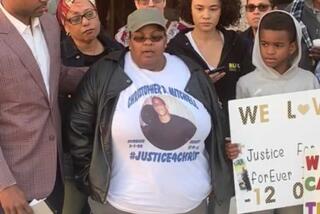Each side cites video in Chino shooting case
- Share via
As they wrapped up the four-week trial of a former sheriff’s deputy who shot an unarmed Air Force police officer last year, the prosecutor and defense attorneys turned for a final time to the bystander’s videotape of the shooting to bolster crucial elements of their cases.
The tape, the prosecutor argued, offered proof that former San Bernardino County Sheriff’s Deputy Ivory John Webb Jr. was not justified when he used potentially deadly force on Senior Airman Elio Carrion, and tried to deceive investigators before he knew the incident had been caught on tape.
Webb’s attorney countered that the video -- when shown in its unenhanced condition and depicting how dark the scene was -- gave jurors a window into the fear and confusion Webb faced when he confronted Carrion and the driver of a Corvette that had just led Webb on a chase at more than 100 mph before crashing on a dark Chino street.
If he is convicted, Webb, 46, could face more than 18 years in prison on charges of attempted voluntary manslaughter and assault with a firearm for shooting Carrion, who was a passenger in the Corvette and was sprawled on the ground after the crash. In the video, Carrion appears to be following Webb’s order to get up off the ground when he is shot.
In his closing argument, Prosecutor R. Lewis Cope said the video recording had served as a witness -- showing jurors a string of unreasonable actions by Webb. He also argued it was proof that Webb used deception when he told officers at the scene that Carrion had lunged at him and ignored warnings to stay on the ground or be shot.
It was only after Webb knew the incident had been taped, Cope told the San Bernardino jury, that the deputy told detectives he thought he saw Carrion reach for a weapon.
After playing a full version of the video, which had been brightened and enhanced by the FBI, Cope played a slow-motion clip of what Webb’s attorneys say was one of Carrion’s most threatening movements -- a pointing motion by the airman toward his chest. Webb had told investigators that he thought Carrion was reaching for a gun inside his jacket.
But Cope emphasized that Webb did not fire his handgun until several seconds after Carrion’s hand had moved. Carrion’s hand was back on the ground when he was shot.
“Where is the threat? Where is the weapon? Where is the reason to shoot this man?” Cope asked.
The prosecutor noted that Webb is never heard on the video cautioning Carrion, saying, “Get up again and I will shoot you,” as the deputy reported to a superior at the scene.
“The statement was made before there was any knowledge there was a videotape,” Cope told the jury of eight men and four women. “Mr. Webb was deceiving his superiors -- telling them about something that did not happen.”
“Mr. Webb is guilty, and I ask you to find that he is guilty,” Cope said.
In his rebuttal, which will continue because he did not finish it, Webb’s lead attorney Michael Schwartz argued that Webb shot in self-defense not just because of one movement by Carrion, but because of a combination of threatening movements that followed a pattern of noncompliance by the airman.
Carrion failed to stop his friend, the driver of the Corvette, from fleeing from police and disobeyed Webb’s orders after the car crashed to be quiet and keep his hands on the ground, Schwartz said.
Just before the deputy opened fire, Schwartz said, Carrion moved his hand toward the opening of his jacket and started rising off the ground in a lunge toward Webb, Schwartz said.
Just before those two actions, Carrion had told Webb he had more training than the deputy in the police and the military. As he reaches toward his chest, Schwartz argued Carrion uttered a challenge -- “You ... believe me, all right!”
“With everything that has transpired at that point ... what could it possibly mean to [Webb] except that he’s reaching for something,” Schwartz said.
“There was an honest fear -- there was a reasonable fear,” he said. “Any officer -- any reasonable officer -- would have the right to shoot that suspect.”
Webb’s attorney dismissed the prosecutor’s claims that Webb made conflicting statements to investigators, arguing that Webb’s description of what happened in a two-hour interview after the shooting was supported by what was seen in the video recording.
Not every statement uttered that night, Schwartz said, can be heard on the videotape. He said even the transcript of the muddied voices on videotape was in dispute.
“We may never know what was said or why it was said,” Schwartz said. That fact alone, he said, should show jurors that there is not proof beyond a reasonable doubt of what happened on that dark street.
Schwartz also attacked the credibility of the prosecution’s key witnesses. Carrion gave differing versions of how much he drank that night, Schwartz said. And the bystander who shot the video recording, Jose Luis Valdes, gave four versions of what Webb said before he fired.
Throughout the case, the prosecutor downplayed the defiant behavior of Carrion and driver Luis Escobedo, Schwartz said. Both were heavily intoxicated when they argued with Webb after the Corvette crashed. Escobedo, who was driving with a suspended license at the time, pleaded guilty in January to evading a peace officer and driving under the influence.
“What this case has been about is minimizing and downplaying [the behavior] of Mr. Carrion and Mr. Escobedo,” Schwartz said, arguing that the two men had put the lives of Webb and all the residents of the area at risk that night.
“Unlike Mr. Escobedo and Mr. Carrion, my client cares about the lives around him,” he said.
On the night of the Jan. 29, 2006, incident, Carrion was celebrating his safe return from Iraq with family and friends at a barbecue at his parents’ house. He testified that Escobedo ignored his repeated pleas to stop the car during the chase and said he never made a threatening movement toward Webb.
The airman, who is 23, survived three shots to his shoulder, back and chest, and is on duty at Barksdale Air Force Base in Louisiana.
More to Read
Sign up for Essential California
The most important California stories and recommendations in your inbox every morning.
You may occasionally receive promotional content from the Los Angeles Times.














